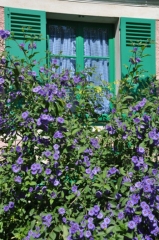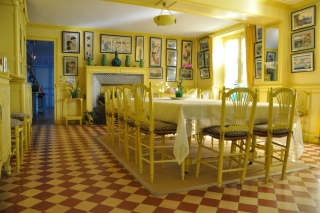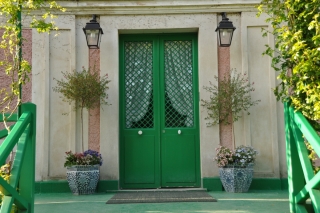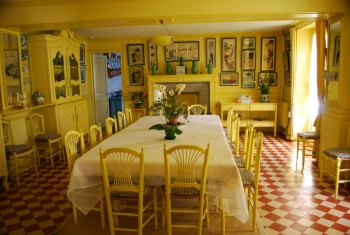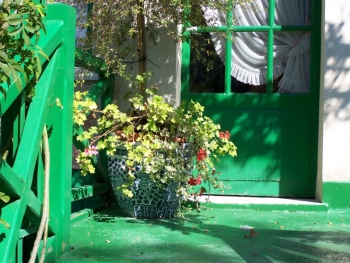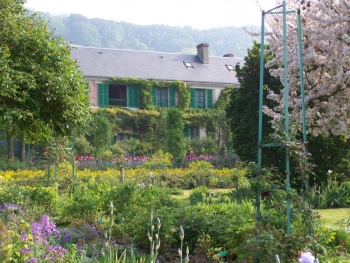February 26, 2015
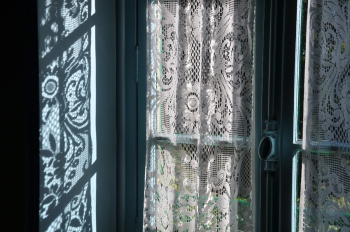
This picture was taken in one of the bedrooms of Monet’s home at Giverny. The house dates back to the mid-1800’s and most of the fixtures are still original, so I suppose this window handle is too. It is a very common model that can be seen in lots of houses of that time. Here it is painted the same pale blue as the window.
What is certainly much more recent are the curtains, although they look ancient and charming. But it is rare to find old curtains in good condition because the light and heat behind the window damage them rapidly. I suppose those were replaced at the restoration of the house in the 1970’s. They are machine made with sort of a floral pattern that resembles lace.
When I was a child I wondered. How can a curtain let us see through, but not enable people standing outside to peep in? Now I don’t any more. I take them for granted. A new surprise awaited me: I’ve realised since I work as a guide and chat with foreigners that curtains, especially lace curtains look french. Do you agree?
They also look country, in my opinion. I must confess that I am a big fan of the Country Living magazine, both the US and UK issues. It is very exciting to explore the country spirit overseas. To learn what people answer to the question ‘What makes my home country?’. Here the curtains would belong to these features. Monet’s house is at the same time a painter’s house, a house of the 19th century, the home of an upper-middle class family, and, being located in the country side, it is definitely a country house.
Posted in Giverny, Monet's House No Comments »
September 6, 2013
According to Claude Monet’s step son Jean-Pierre Hoschedé, the painter loved blue flowers.
This beautiful solanum, a plant belonging to the family of tomatoes and potatoes, is covered with simple little blue flowers.
It matches the colors of the kitchen window with its blue squared curtains, a very typical french pattern called vichy fabric.
In late Summer, plants are at the top of their heigth. With a bit of imagination, the flowers of the Giverny garden look like big waves splashing against the walls of the house.
Posted in Monet's House, Monet's flower garden No Comments »
December 17, 2012
Here is another view of
Claude Monet’s yellow dining room at Giverny. Bright, charming, cozy, it is often considered inspiring by people seeking new ideas for their home.
The red and creamy tiles on the floor are typical for the local 19th Century style and can be found in many houses around. The furniture, including buffets and chairs, was also widely spread. Monet’s novelty was to paint it in these two tones of yellow.
Nevertheless, a strange spell lies on this dining room. Many visitors remember it as the “yellow kitchen”. However, the neighboring kitchen is absolutely blue, as you can spot through the door.
Posted in Monet's House 15 Comments »
May 28, 2012
The painter Claude Monet had a special eye for refined and simple countryside elegance.
Here, the main entrance to his home at Giverny, an harmony of tender pink and bright green, enhanced by two blue Chinese pots.
The balance is obtained by the symetry of the decoration.
The curtains behind the iron cast door make it look like a puppet theatre.
Posted in Monet's House 2 Comments »
December 2, 2011
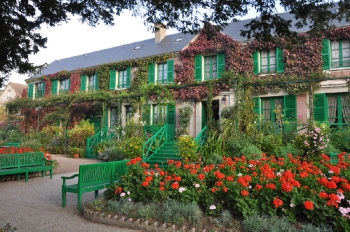 Flashing reds and greens in the soft light of October, this is what Monet’s garden offers in October in the area in front of the painter’s house.
Flashing reds and greens in the soft light of October, this is what Monet’s garden offers in October in the area in front of the painter’s house.
The “Monet green” spreads on benches, shutters, stairs… creating a strong contrast with the formal geranium beds and the virginia creeper on the façade.
Posted in Monet's House No Comments »
September 29, 2011
A look through the window of Monet’s studio, on the ground floor of his house at Giverny.
The garden appears like an additional painting among the canvases hanging on the wall.
Posted in Monet's House No Comments »
August 2, 2009
I have just been given the right to take pictures inside of Monet’s House. I am thrilled being able to comment on this very special home I love!
Taking photographs in the museum is forbidden for several reasons, especially because of the very fragile japanese woodblocks that hang on the walls. Monet didn’t want his own work to decorate his home: it was work! He preferred something more exotic and fun. He would hang them everywhere except in his studio, in the kitchen and in his bedroom.
I don’t know what strikes visitors most when they enter the most beautiful room of the house, the famous dining room. The Japanese prints cover the walls, almost masking them, their mainly blue color matching the yellow furniture, walls and moldings.
It is strangely modern, especially when compared with the very heavy and dark fashion in matter of decoration in Victorian times. Bright, and stunning. Everybody says waow! when stepping inside of this yellow dining room, and most people like it. But for some visitors, it is too yellow.
Posted in Monet's House 11 Comments »
June 8, 2008
Monet’s home in Giverny has three entrances, each one dedicated to a particular use.
This is typical for the time when the house was built, in the 19th century.
One door was devoted to Monet’s own use. It leads directly to his first studio and to the stairs to his bedroom. It enabled Monet to go in and out without disturbing the family life – he liked to get up exceedingly early in the morning – or perhaps without being disturbed by the family life – there were eight children in the family. This entrance could be called the professional one.
There was of course a main entrance for family members and guests.
The third one was a domestic entrance leading directly to the kitchen.
Posted in Monet's House No Comments »
May 21, 2008
Monet was 42 when he arrived in Giverny.
Let’s say he was in his forty-third year, and he spent forty three years in Giverny. Exactly half of his life!
When he arrived he was looking for a big house to live with his family. He was lucky enough to find this one.
He felt so happy there he never wanted to move anymore.
Posted in Monet's House No Comments »
April 23, 2008
Monet’s home is painted into pink, a pale pink that matches the Japanese cherry trees and the crab apple trees blooming in April, at the beginning of the season.
In the spring freshness, pink seems to be everywhere, from the tulips aligned in front of the house in island beds to the many pansies scattered in the mixed borders.
All these pinks are enhanced by the tender green of the new born leaves and grass.
Posted in Monet's House Comments Off on The Pink House

